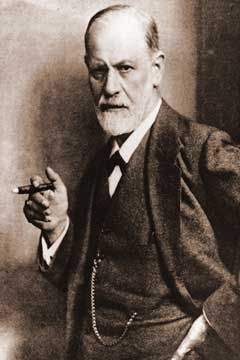ЭДИПОВ КОМПЛЕКС (OEDIPUS COMPLEX) Конфигурация отношения ребенка к родителям, основанная на фантазии и возникающая обыкновенно в разгаре инфантильной генитальной стадии. Она подразумевает идентификацию ребенка с родителем своего пола и либидный интерес к родителю противоположного пола. Фантазия ребенка о заступании на место одного из родителей, чтобы играть его роль по отношению к другому родителю, обычно сопровождается целым рядом конфликтов, так как у него имеются восхищение родителем одного с собой пола и преданность ему, а также страх кары за то, что он занял не свое место.
ЭКСГИБИЦИОНИЗМ (EXHIBITIONISM) Демонстрация себя с целью получить инстинктивное удовлетворение от осознавания того, что являешься объектом разглядывания и вызываешь реакцию наблюдающего.
ЭКСТЕРНАЛИЗАЦИЯ (EXTERNALIZATION) Защитный механизм, который характеризуется тенденцией располагать вне себя собственные инстинктные желания, конфликты, настроение и стиль мышления с тем, чтобы они воспринимались как чужие. Необходимо отличать от проекции.
ЭНЕРГИЯ, ПСИХИЧЕСКАЯ (ENERGY, PSYCHIC) Гипотетическая метафорическая сила в ментальной деятельности, введенная для объяснения кажущегося количественного аспекта определенных элементов психической жизни. Всегда рассматривалась как похожая, но не аналогичная понятию энергии, принятому в физике.
ЭПИГЕНЕЗ (EPIGENESIS) Принцип развития, заимствованный из эмбриологии. Был впервые применен к психоаналитической теории Эриксоном (1959) и подразумевает, что личностный рост подчинен определенным законам, общим для всего, что растет. У каждого типа организма имеется своя программа, в соответствии с которой для каждой части наступает свое время особой значимости, и так до тех пор, пока из этих частей не образуется функционирующее целое. Соответственно, происходящие в процессе развития события по мере роста личности возникают с определенной частотой и в определенной последовательности.
ЭРОГЕННЫЕ ЗОНЫ (EROGENOUS ZONES) Области тела, стимуляция которых приводит к чувству полового удовлетворения или возбуждения. Вдобавок к гениталиям, ими могут быть и другие области тела. В их развитии имеется последовательность, когда значение имеют последовательно оральная, анальная и генитальная зоны.
Abelin, E. L. (1971) The role of the father in the separation — individuation process In Separation — individuation Essays in honor of Margaret S. Mahler, ed. J. McDevitt and C. Settlage New York Int. Univ. Press, pp. 229-252.
Abelin, E. L. (1975) Some further observations and comments on the earliest role of the father Int. J. Psychoanal, 56 293-302.
Abend, S. M. (1982) Serious illness in the analyst Countertransference considerations J. Amer. Psychoanal. Assn., 30 365-379.
Abraham, H. C., and Freud, E. L., eds (1965) A psychoanalytic dialogue: The letters of Sigmund Freud and Karl Abraham, 1907-1926, New York Basic Books Abraham, K. (1916) The first pregenital stage of the libido inselected papers on psychoanalysis New York Basic Books, 1953, pp. 248-279.
Abraham, K. (1920) Manifestations of the female castration complex In Selected papers on psychoanalysis. New York Basic Books,1953, pp. 338-369.
Abraham, K. (1924a) The influence of oral erotism on character formation In Selected papers on psycho-analysis New York Basic Books, 1953, pp. 393-406.
Abraham, K. (1924b) A short study of the development of the libido, vicwed in the light of mental disorders In Selected papers on psycho-analysis New York Basic Books, 1953, pp. 418-501.
Abrams, S. (1977) The genetic point of view Historical antecedents and developmental transformations J. Amer. Psychoanal. Assn., 25 417-426.
Aichhorn, A. (1925) Wayward youth New York: Viking Press, 1965.
Ainsworth, M. D. (1962) The effects of maternal deprivation: A review of findings and controversy in the context of research strategy. In Deprivation of maternal care. A reassessment of its effects Public Health Papers No 14 Geneva WHO, pp. 97-165.
Ainsworth, ML D. (1964) Patterns of attachment behaviour shown by the infant in interaction with his mother Mernll — Palmer Q, 10 51-58.
Ainsworth, M. D.; Blehar, M.; Waters, E.; and Wall, S. (1978) Patterns of attachment Hillsdale, N. J. Eribaum.
Alpert, A. (1941) The latency period: Re-examination in an educational setting Amcr. J. Orthopsychtat., II: 126-132.
Als, H.; Tester, B. M.; and Braselton, Т. В. (1979). Dynamics of the behavioral organization of the premature infant: A theoretical perspective. In Infants born at risk: Behavior and development, ed. T. M. Field, A. M. Sostek, S.; Goldberg, and H. H. Shuman. New York Spectrum, pp 173-192.
Amsleidam, B К (1972) Mirror self-image reactions before age 2. Developmental Psychology, 5 297-305
Anders, T. F. (1978) Home recorded sleep in two- and nine-month-old infants. J. Amer. Acad. Child Psychlat., 17 421-432.
Anders, T. F. (1982) Biological rhythms in development Psychosom. Med, 44 bl-72.
Anders, T. F., and Zcanah, С. Н. (1984) Early infant development from a biological point of view in Frontiers of infant psychiatry Vol 2, ed. J. Call, E. Galenson, and R. L. Tyson New York Basic Books, pp. 55-69.
Anthony, E. J. (1957) Symposium on the contribution of current theories to an understanding of child development, the system makers Piaget and Freud Bnt. J. Med. Psychol, 30 255-269.
Anthony, E. J. (1982) Normal adolescent development from a cognitive viewpoint / Amer. Acad. Child Psychlat., 21 318-327.
Anthony, E. J., and Cohler, B. J., eds. (1987) The invulnerable child New York Guilford Press.
Arlow, J. A. (1969) Unconscious fantasy and disturbances of conscious experience Psychoanal Q, 38 1-27.
Arlow, J. A. (1977) Affects and the psychoanalytic situation Int.. J Psychoanal, 58 157-170.
Arlow, J. A., and Brenner, C. (1964) Psychoanalyttic concept and the structural theory New York Int. Univ. Press.
Balint, M. (1959) Primary love and psycho analytic technique London Tavistock.
Balint, M. (1968) The basic fault Therapeutic aspects of regression London Tavistock.
Balint, E. (1973) Technical problems found in the analysis of women by a woman analyst: A contribution to the question «What does a woman want?» Int. J. Psychoanal., 58 289-300.
Barnett, M. C. (1966) Vaginal awareness in the infancy and childhood of girls. J. Amer. Psychoanal. Assn., 14 129-141.
Basch, M. F. (1976) The concept of affect Are—examination J. Amer. Psycho-anal Assn., 24, 759-778.
Basch, M. F. (1977) Development psychology and explanatory theory in psychoanalysis Ann. Psychoanal., 5 229-263.
Beebe, B. (1986) Mother — infant mutual influence and precursors of self- and object I eprescntations. Empirical studies of psychoanalytic theories Vol 2, ed. J. Masling Hillsdale, N. J. Eribaum, pp. 27-48.
Beebe, В., and Stern, D. (1977) Engagement — disengagement and early objective experiences. In Communicative structures and psychic structures, ed. N. Freeman and S. Grand New York Plenum Press, pp. 35-50.
Bell, A. (1961). Some observations on the role of the scrotal sac and the testicles. J. Amer. Psychoanal. Assn., 9:261-286.
Bell, R. Q. (1974). Contributions of human infants to caregiving and social interaction. In The effect of the infant on its caregiver, ed. J. M. Lewis and L. A. Rosenblum. New York: Wiley, pp. 1-19. Bell, R. Q., and Harper, L. V. (1977). Child effects on adults. Hilisdale, N. J.: Eribaum.
Benedek, T. (1959). Parenthood as a developmental phase: A contribution to the libido theory. Amer. Psychoanal. As. m., 7:389-417.
Benjamin, J. D. (1961a). Some developmental observations relating to the theory of anxiety. Amer. Psychoanal. Assn., 9:652-668.
Benjamin, J. D. (1961b). The innate and the experiential in child development. In Lectures on experimental psychiatry, cd. H. W. Brosin. Pittsburgh: Univ. of Pittsburgh Press, 1961, pp. 19-42.
Benjamin, J. D. (1963). Further comments on some developmental aspects of anxiety. In Counterpoint, ed. H. S. Gaskill. New York: Int. Univ. Press, pp. 121-133.
Beres, D. (1958). Vicissitudes ofsuperego functions and superego precursors in childhood. Psychoanal. Study Child, 13:324-352.
Beres, D. (1981). Self, identity, and narcissism. Psychoanal. Q., 50:515-534.
Bergman, D., and Escalona, S. K. (1949). Unusual sensitivities in very young children. Psychoanal. Study Child, 3/4:333-352.
Bernfeld, S. (1938). Types of adolescence. Psychoanal. Q., 7:243-253.
Bernstein, D. (1983). The female superego: A different perspective. Int. J. Psychoanal., 64:187-201.
Bertalanffy, L. von (1968). General system theory: Foundations, development, applications. New York: George Braziller.
Bettelheim, B. (1976). Theusesofenchantment: The meaning and importance of fairy tales. London: Thames and Hudson.
Bibring, E. (1947). The so-called English School ofpsychoanalysis Psychoanal. Q., 16:69-93.
Bibring, G. L.; Dwyer, T. F; Huntington, D. S.; and Vallenstein, A. F. (1961). A study of the psychological processes in the pregnancy and earliest mother — child relationship. Psychoanal. Study Child, 16:9-72.
Blos, P. (1958). Preadolescent drive organization. J. Amer. Psycho-anal. Assn., 6:47-56.
Blos, P. (1962). On adolescence: A psychoanalytic interpretation. New York: Free Press.
Blos, P. (1967). The second individuation process of adolescence. Psychoanal. Study Child, 22:162-186.
Blos, P. (1968). Character formation in adolescence. Psychoanal. Study Child, 23:245-263.
Blos, P. (1970). The young adolescent: Clinical studies. New York: Free Press.
Blos, P. (1974). The genealogy of the ego ideal. Psychoanal. Study Child, 29:43-88.
Blos, P. (1976). How and when does adolescence end? In Adolescent psychiatry. Vol. 5, cd. S. C. Feinstein and P. Giovacchini. New York: Aronson, pp. 5-17.
Blos, P. (1979). The adolescent passage. New York: Int. Univ. Press.
Blum, H. P. (1976). Masochism, the ego ideal, and the psychology of women. Amer. Psychoanal. Assn., 24 (Suppi.): 157-191.
Blum, H. P. (1978). Symbolic processes and symbol formation. Int. J. Psychoanal., 59:455-471.
Blum, H. P. (1982). Theories of the self and psychoanalytic concepts: Discussion. Amer. Psychoanal. Assn., 30:959-978.
Blum, H. P. (1985). Superego formation, adolescent transformation, and the adult neurosisy. Amer. Psychoanal. Assn., 33:887-909.
Boesky, D. (1988). The concept of psychic structure. J. Amer. Psychoanal. Assn., 36 (Suppi.): 113-135.
Bornstein, B. (1951). On latency. Psychoanal. Study Child, 5:279-286.
Bornstein, B. (1953). Fragment of an analysis of an obsessional child: The first six months of analysis. Psychoanal. Study Child, 8:313-332.
Bower, T. G. R. (1974). Development in infancy. San Francisco: Freeman Press.
Bowlby, J. (1958). The nature of the child's tic to his mother. Int. J. Psychoanal., 39:350-373.
Bowlby, J. (1960a). Grief and mourning in infancy and early childhood. Psychoanal. Study Child, 15:9-52.
Bowlby, J. (1960b). Separation anxiety. Int. J. Psychoanal., 41:89-113.
Bowlby, J. (1961). Processes of mourning. Int. J. Psychoanal., 42:317-340.
Bowlby, J. (1969). Attachment and loss. Vol. Attachment. New York: Basic Books.
Bowlby, J. (1973). Attachment and loss. Vol. 2, Separation, anxiety, and anger. NewYork: Basic Books.
Bowlby, J. (1980). Attachment and loss. Vol. 3, Loss, sadness and depression. NewYork: Basic Books.
Bowlby, J. (1981). Psychoanalysis as a natural science. Int. Rev. Psychoanal., 8:243-256.
Brazelton, Т. В. (1973). Neonatal behavioral assessment scale. London: Spasticslnternational Medical Publications.
Brazelton, Т. В. (1982). Joint regulation ofneonate parent behavior. In Social interchange in infancy, ed. E. Z. Tronick. Baltimore: University Park Press, pp. 7-27.
Brazelton, T. B., and Als, H. (1979). Four early stages in the development ofmother — infant interaction. Psychoanal. Study Child, 34:349-369.
Brazelton, Т. В.; Koslowski, В.; and Main, M. (1974). The early mother — infant interaction. In The effect of the infant on its caregivcr, cd. M. Lewis and L. Roscnblum. New York: Wiley, pp. 49-77.
Bialriton, Т В.; Tronick, E.; Adamson, I.; Als, H.; and Wise, S. (1975). Early mother — infant reciprocity. In Parent — infant interaction. Ciba Foundation Symposium 33. Amsterdam: Elsevier, pp. 137-154.
Brenner, C. (1959). The masochistic character: Genesis and treatment./. Aner. Psychoanal. Assn., 7:197-226.
Brenner, C. (1974). On the nature and development of affects: A unified theory. Psychoanal. Q., 43:532-556.
Brenner, C. (1979). The components of psychic conflict and its consequences in mental life. Psychoanal. Q., 48:547-567.
Brenner, C. (1982). The mind in conflict. New York: Int. Univ. Press.
Brenner, C. (1987). Notes on psychoanalysis by a participant observer: A personal chronicle. J. Amer. Psychoanal. Assn., 35:539-556.
Breuer, J. and Freud, S. (1893-1895). Studies on hysteria. S. E., 2.
Brody, M. W, and Mahoney, V. P. (1964). Introjection, identification and incorporation. Int. J. Psychoanal., 45:57-63.
Brody, S. (1980). Transitional objects: Idealization of a phenomenon. Psychoanal. Q., 49:561-605.
Brody, S. (1981). The concepts of attachment and bonding. Amer. Psychoanal. Assn., 29:815-829.
Brody, S. (1982). Psychoanalytic theories of infant development and its disturbances: A critical evaluation. Psychoanal. Q., 51:526-597.



